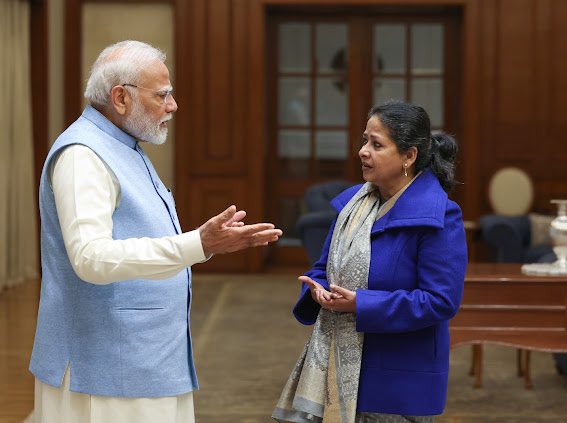North News
New Delhi, July 23
Indian Finance Minister Nirmala Sitharaman on Friday introduced new income tax slabs in her seventh Union Budget presented in the Lok Sabha on Tuesday. The proposed slabs are as follows: up to ₹3 lakh, nil; ₹3-7 lakh, 5%; ₹7-10 lakh, 10%; ₹10-12 lakh, 15%; ₹12-15 lakh, 20%; and above ₹15 lakh, 30%. Additionally, Sitharaman announced reductions in duties that will make several items cheaper, including gold, silver, platinum, mobile phones, and cancer drugs. The basic customs duty on gold and silver has been cut to 6%, and on platinum to 6.4%. The duty on mobile phones and mobile chargers has been reduced to 15%.
- Personal Income Tax
- Under the new tax regime. the standard deduction for salaried employees is proposed to be increased from ₹50,000/- to ₹75,000/-.
- Similarly, deduction on family pension for pensioners is proposed to be enhanced from ₹ 15,000/- to ₹ 25,000/-. This will provide relief to about 4 crore salaried individuals and pensioners.
- In the new tax regime, the tax rate structure is proposed to be revised, as follows:
| 0-3 lakh rupees | Nil |
| 3-7 lakh rupees | 5 % |
| 7-10 lakh rupees | 10 % |
| 10-12 lakh rupees | 15 % |
| 12-15 lakh rupees | 20 % |
| Above 15 lakh rupees | 30 % |
Budget Highlights:
- The government has allocated funds for social sectors, including health (Rs 89,287 crore), education (Rs 1,25,638 crore), and rural development (Rs 2,65,808 crore).
- Defence expenditure is allocated Rs 4,54,773 crore
- Subsidies (food, fertilizer, and petroleum) are estimated at Rs 3,81,175 crore.
- Total capital expenditure is projected at Rs 11,11,111 crore, a 16.9% increase over the revised estimates for 2023-2024. Effective capital expenditure is estimated at Rs 15,01,889 crore, an 18.2% rise from the previous year.
- Fiscal deficit is estimated at Rs 16,13,312 crore, or 4.9% of GDP, with a revenue deficit projected at Rs 5,80,201 crore, or 1.8% of GDP.
- Interest payments are projected at Rs 11,62,940 crore.
- Revenue receipts are estimated at Rs 31,29,200 crore, with net tax revenue to the Centre projected at Rs 25,83,499 crore. Non-tax revenue is expected to be Rs 5,45,701 crore. Total capital receipts (including non-debt and debt receipts) are estimated at Rs 15,50,915 crore.
Other highlights of Budget 2024-25
Key Pointers
- In this Budget, Govt has focused on employment, skilling, MSMEs, and the middle class. Prime Minister’s package of 5 schemes and initiatives for employment, skilling and other opportunities for 4.1 crore youth over a 5-year period with a central outlay of 2 lakh crore. This year, provision of ₹ 1.48 lakh crore has been made for education, employment and skilling.
- 1stScheme is for First Timers will provide one-month wage to all persons newly entering the workforce in all formal sectors.
- 2ndSchemeis for Job Creation in manufacturing where an incentive will be provided at specified scale directly both to the employee and the employer with respect to their EPFO contribution in the first 4 years of employment
- 3rdSchemewill cover additional employment in all sectors. All additional employment within a salary of ₹1 lakh per month will be counted. The government will reimburse to employers up to ₹ 3,000 per month for 2 years towards their EPFO contribution for each additional employee.
- The 4th scheme under the Prime Minister’s package, for skilling in collaboration with state governments and Industry. 20 lakh youth will be skilled over a 5-year period.
- 5th scheme under the Prime Minister’s package, government will launch a comprehensive scheme for providing Internship opportunities in 500 top companies to 1 crore youth in 5 years
- For helping our youth who have not been benefitted under any government initiatives, financial support for loans upto ₹ 10 lakh for higher education in domestic institutions will be provided.
- E-vouchers for this purpose will be given directly to 1 lakh students every year for annual interest subvention of 3% of the loan amount.
- For promoting women-led development, the budget carries an allocation of more than ₹ 3 lakh crore for schemes benefitting women and girls.
- More than 100 branches of India Post Payment Bank will be set up in the North East region to expand the banking services.
- This year, a provision of ₹ 2.66 lakh crore for rural development including rural infrastructure has been made.
- The limit of Mudra loans will be enhanced to ₹ 20 lakh from the current ₹ 10 lakh for those entrepreneurs who have availed and successfully repaid previous loans under the ‘Tarun’ category.
- Govt will facilitate development of investment-ready “plug and play” industrial parks with complete infrastructure in or near 100 cities.
- 12 industrial parks under the National Industrial Corridor Development Programme also will be sanctioned.
- Phase IV of PMGSY will be launched to provide all-weather connectivity to 25,000 rural habitations which have become eligible in view of their population increase.
- To bolster the Indian start-up eco-system, boost the entrepreneurial spirit and support innovation, the so-called angel tax for all classes of investors has been abolished.
- Monetary limits for filing appeals related to direct taxes, excise and service tax in the Tax Tribunals, High Courts and Supreme Court has been increased to ₹ 60 lakh, ₹ 2 crore and ₹ 5 crore respectively.
- To improve social security benefits, deduction of expenditure by employers towards NPS is proposed to be increased from 10 to 14 % of the employee’s salary.
- Under the new tax regime. the standard deduction for salaried employees is proposed to be increased from ₹50,000/- to ₹75,000/-.
- Similarly, deduction on family pension for pensioners is proposed to be enhanced from ₹ 15,000/- to ₹ 25,000/-. This will provide relief to about 4 crore salaried individuals and pensioners.
- As a result of these changes, a salaried employee in the new tax regime stands to save up to ₹ 17,500/- in income tax.
















